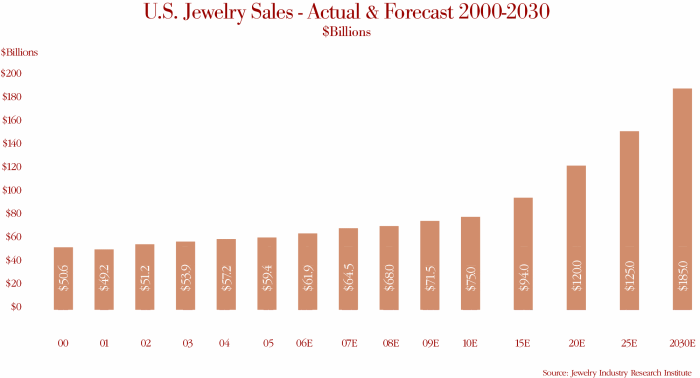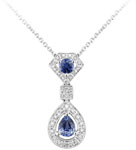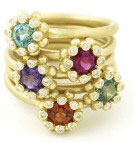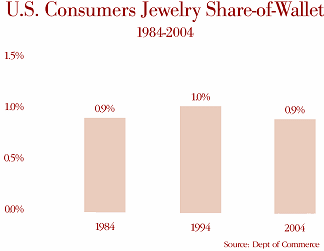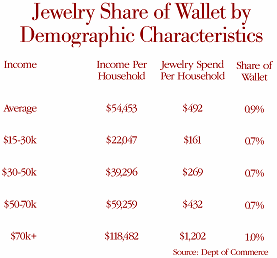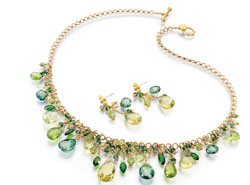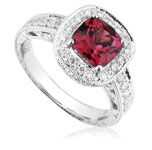Forecast & Outlook : Solid but not Robust Demand for Jewelry
October 09, 06 by

U.S. jewelers can expect their sales to grow by about 5 percent annually over the next two decades, based on our new jewelry industry forecast for retail sales. We are currently projecting that jewelry sales will grow by a compounded annual growth rate (CAGR) within a range of about 4.4 percent to 5.3 percent between now and 2025, with a mid-point of about 4.9 percent CAGR.
The graph below summarizes our latest jewelry sales forecast for the U.S. market through 2030.
Jewelry Demand To Be Less Robust Than Earlier Forecasts
The long term outlook for jewelry demand in the U.S. is less rosy than earlier forecasts, though solid gains are expected, based on findings from newly analyzed research. Our current forecast calls for jewelry sales to grow by about 4.9 percent annually; previous forecasts had called for the jewelry industry to grow at a rate near 5.6 percent annually for the next two decades.
The primary reason for the reduced forecast relates to the “Baby Boom Bust.” In past forecasts, demographers and market forecasters had relied on the likelihood of heavy jewelry spending by Boomers as they approached the age of 50, the so-called “sweet spot” for jewelry purchases. The reality is that Boomers are not spending nearly as much on jewelry as had been projected. Because Boomers had their families later in life, they are still saddled with college expenses and other child-related costs; in contrast, their parents had reached their financial golden years by age 50 and had ample discretionary income to spend on jewelry and other luxury goods.
Total U.S. Retail Sales Forecasts Toned Down
Previous forecasts for American consumer demand suggested that total U.S. retail sales (all categories except automobiles) would rise by about 4.8 percent (CAGR) for the next two decades. Those projections have also been toned down; we are now looking for retail sales gains closer to 4.5 percent (CAGR) for the next 20 years or so. Again, both demographic trends as well as some external factors - primarily low inflation - are expected to put a damper on retail demand.
Based on these new forecasts, jewelry sales gains are expected to outpace the rate of increase for all retail sales, but by less of a margin than previous forecasts.
Forecast Range -
$140-170 Billion Jewelry Sales by 2025
Our current forecast calls for U.S. jewelry sales in 2025 to be about $152 billion, with a possible range between $140 billion and $170 billion.
Factors That Will Affect the Forecast
There are two sets of factors that will affect our jewelry sales forecast over the next 20 years: internal (industry) factors and external (environmental) factors.
Some of the internal factors that will affect consumer demand for jewelry are as follows:
w Jewelry Industry Sales Development Programs – The jewelry industry has been proactively developing programs to boost jewelry demand:
-Accelerated Introduction of New Fashion-able Merchandise - Jewelry manufacturers have stepped up the introduction of new jewelry merchandise. New, exciting, innovative products stimulate demand, usually with a “multiplier” effect.
- New Market Niches Targeted - Jewelers have stepped up their efforts to reach new markets with new products. Younger consumers, traditionally an overlooked group, appear to have substantial buying power; thus, jewelers have begun to target this group. Jewelry with unisex styling appears to be gaining market share. Merchants are also targeting the market for men’s jewelry. The gay and lesbian market represents a significant opportunity, particularly as same-sex partnerships increase and same-sex marriages are perhaps legalized.
w New Channels of Distribution Utilized - Bricks-and-mortar jewelry merchants have generally embraced e-commerce. Online sales now represent just over 3 percent of total U.S. jewelry sales, and are expected to reach 7-8 percent of total jewelry sales by the end of the decade. In addition, mall-based mass-market jewelers have begun to open stores in off-mall strip centers and are testing urban locations in Manhattan and Chicago.
w New Marketing Opportunities - De Beers has developed major marketing programs such as three-stone jewelry with an emotionally-charged theme, Past, Present, and Future, as well as Right Hand Rings targeted to women for self-purchase. Other diamantaires such as Hearts On Fire have created compelling marketing programs. Celebrity jewelry endorsements have proliferated; research shows that U.S. shoppers imitate celebrity fashion trends.
w Industry Consolidation Culling Winners From Losers - With today’s highly mobile society, consumers need to have the confidence, security, and knowledge that a national chain of jewelry stores will stand behind their purchase. Inefficient mass-market jewelry merchants - mostly independents - are being replaced by chains, roughly on a one-to-one basis. These dominant chain jewelers will bring operating efficiencies such as vertical integration that will give the consumer a better value and boost profits as sales per store rise. Longer term, it is possible that two or three major jewelry chains will dominate the mass market, similar to most other retail categories. An opportunity for independents will continue to exist at the high-end and the low-end of the market.
w Brands Increase Consumer Buying Confidence - Because consumers have little product knowledge, branded jewelry merchandise is an important creator of value and confidence for shoppers. There has been a sharp rise in branded jewelry recently, a trend that is expected to continue.
Some of the external factors that will affect jewelry demand include the following:
w Compelling Demographics - Three positive demographic factors are poised to help drive jewelry demand longer term.
- High-income Household Growth - The projected sharp increase in high-income households over the next 20 years is
poised to drive jewelry demand to new heights.
- Net Population Gain - The birth rate in the U.S. is resulting in a net population gain – more than three million people per year – in stark contrast to some markets in the world such as Eastern Europe and China where the birth rate is so low that the population is decreasing.
- More women earning a paycheck - In 1950, only one-third of all American adult females had a paid job outside of the home. Today, two-thirds of all women hold down a part-time or full-time job outside of the home. Women make up nearly half of the American workforce. As a result, they have their own discretionary income to spend on jewelry and other luxuries.
w More Weddings - As a result of a significant rise in the U.S. birth rate beginning in the 1980s, the number of marriages annually is expected to increase by about 30 percent over the next ten years when compared to the annual number of marriages in the decade of the 1990s. About 80 percent of American brides receive a diamond engagement ring, currently valued at more than $2,750. In addition, since roughly 50 percent of all marriages end in divorce, the rate of second and third marriages is expected to continue to rise. Repeat brides typically receive larger, better quality, more expensive diamond rings.
w Rising Affluence - Wealthy consumers are prime jewelry buyers. Consumers’ balance sheets are being strengthened by four factors:
- Rising Home Prices - Homes are typically the largest asset on consumers’ balance sheets; long term, home prices have risen about 7 percent annually in the U.S.
- Rising Stock Market – Aside from periodic pullbacks, the U.S. stock market has posted solid though moderate gains, a trend that is expected to continue.
- Increased Inheritances – Consumers’ net worth should continue to rise, fueled by a large number of inheritances over the next 20 years.
- Manageable Debt Burden – While the U.S. household debt burden continues to rise, it is still at manageable levels, based on record-high household net worth levels.
w Solid Economic Fundamentals –Many fundamental factors affect consumer spending – interest rates, tax rates, inflation, wage gains, unemployment, and others; virtually all are showing positive trends. Further, the Fed has shown that it can reduce economic volatility in the U.S. Finally, the long-term outlook for the U.S. economy remains bright.
In addition, there are other events that will affect jewelry demand. Some of these events are determined by demographic changes (birth rates, for example); others are created promotions (Mother’s Day, for example). Most of the events are “annuity events,” which occur yearly. Some of the key events that trigger jewelry demand follow:
w Holiday Season – Christmas, Chanukah, and Kwanza represent the most important selling period of the year – November and December. Jewelers typically generate about one-third of their annual sales – and most of their annual profits – in this two-month period.
w Valentine’s Day – This February love-fest helps drive demand for jewelry, especially in the lower price range.
w Mother’s Day – Consumers honor their mothers with gifts of jewelry.
w Graduation, birthdays, and other special events – These can be annual events (birthdays) or special one-time events (graduation from high school). The one-time events are called “life-cycle events.”
Jewelry Is Losing Consumers’ Share of Wallet
Over the past 20 years, consumers’ share-of-wallet related to jewelry spending has waxed and waned, according to new consumer expenditure research by the U.S. Department of Commerce. In 1984, American consumers spent roughly 0.9 percent of their total pretax income on jewelry. By 1994, jewelry spending had risen to 1 percent of pretax income. However, in the past several years, jewelry expenditures have slipped back to about 0.9 percent share-of-wallet. The vacillation in jewelry’s share-of-wallet is shown on the graph below.
Jewelry Share of Wallet by Demographic Characteristics
w Income - Jewelry share of wallet among high income consumers is above the national average. Jewelry share of wallet for all other key income categories is slightly below average.
w Education - As expected, jewelry share-of-wallet among better-educated, higher-income consumers is greater than their less well-educated counterparts.
w Occupation - Jewelry share of wallet does not vary greatly by occupation. High-income professionals spend slightly more on jewelry. Likewise, share-of-wallet for jewelry spending is also higher among construction workers, many of whom are well paid.
w Age - Interestingly, jewelry share-of-wallet among consumers age 45-54 is much lower than average. On the other hand, consumers age 55-64 have a higher-than-average jewelry share of wallet.
w Household Size - Smaller households tend to have a greater share-of-wallet for jewelry.
w Race / Ethnicity - Jewelry share of wallet varies greatly by race and ethnicity. Both Blacks’ and Asians’ jewelry share of wallet is well below the national norm.
What’s Up? What’s Down?
Where have American consumers diverted their money in recent years? Four expense categories have shown notable spending increases: education, healthcare, insurance, and dining out.
w Dining Out - It is no surprise that time-pressed consumers are opting to dine out more frequently. The “stay-at-home mom” who prepares three nutritious meals a day for her family is an anomaly in today’s world.
w Health Care - The U.S. health care system is the most costly in the world – and the most broken, according to some analysts. Health care costs are soaring due to two factors: 1) the industry is dominated by for-profit companies; and 2) health care-related litigation costs are sky-high. Consumers have virtually no control over their health care costs.
w Insurance - Americans are among the world’s largest users of private insurance. In a country where capitalism rules, there is no government umbrella of social programs to provide insurance for most people.
w Education - While education costs have risen sharply, more Americans are opting to remain in school for advanced degrees. In addition, many American adults are taking “continuing education” classes.
Americans have managed to cut back their spending on some categories, including the following:
w Food - The lack of food price inflation has helped trim Americans’ food bill.
w Housing - While consumers have invested heavily in housing, their salaries and wages are rising faster than the total costs associated with owning (or renting) a home.
w Apparel - Cheap overseas labor in third world countries has resulted in lower-priced apparel for American shoppers.
w Transportation - While aggregate transportation costs has come down over the past decade, soaring oil prices will reverse this trend in 2005 and beyond.
w Entertainment and Vacations - Surprisingly, Americans are spending less money on entertainment and vacations. In part, this is due to the long hours that the typical American works, which means they have less time for vacation and leisure activities.
JEWELRY GIFT-GIVING IS DOWN
Consumer spending on jewelry as a gift in the U.S. has declined steadily over the past two decades. Based on new data from the U.S. Department of Commerce, total spending on jewelry as a gift by all consumers has fallen from 17.4 percent of total jewelry expenditures in 1984 to 14.7 percent of total jewelry expenditures in 2004. The graph below illustrates this trend.
The decline in gifting of jewelry follows a broader trend among American consumers. In general, U.S. households are less generous now than in the past. Among all consumers, spending for gifts has declined significantly over the past 20 years. In 1984, consumers spent about 3 percent of their household budgets on gifts - all categories - for family, friends, and others. Today, they spend just over 2 percent of their budgets on gifts.
Expenditures on Jewelry As A Gift - By Demographics
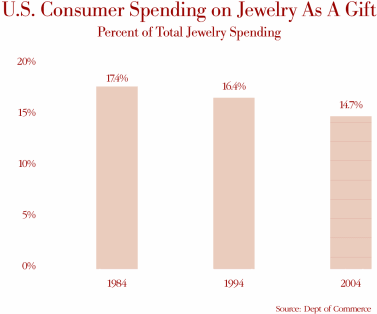 |
-
Income - Those who don’t have much give the most. That’s what the statistics tell us about lower income consumers. Americans with incomes under $15,000 spend about 22 percent of their jewelry budget on jewelry as a gift for others. Conversely, the highest income consumers spend the smallest amount - 12.8 percent of their jewelry budgets - on jewelry as a gift. While total household jewelry expenditures correlate very closely with income levels - higher income consumers spend proportionally more on jewelry - expenditures for jewelry as a gift do not correlate with income levels, as the graph below illustrates.
-
Age - The youngest group of consumers as well as seniors spend more of their jewelry budgets on gift jewelry than other age groups. This is no surprise: young unmarried consumers are giving gifts of jewelry to their friends for weddings and other life cycle events. Seniors are giving jewelry to their children and grandchildren.
-
Household Size - Consumers in single person households spend nearly 40 percent of their jewelry budget on gifts. Households with two or more people spend less than 10 percent of their jewelry budgets on gifts.
-
Education - The higher the educational attainment, the less spent on jewelry as a gift.
-
Housing Tenure - Renters tend to spend more on jewelry as a gift than homeowners.
-
Race & Ethnicity - Asian consumers spend more than average on jewelry for gifts while blacks spend far less than average on jewelry as a gift. White consumers spending on jewelry as a gift is at the national norm.
-
Occupation – Spending on jewelry as a gift by occupation yields some surprising trends. Professionals, who buy more jewelry than any other major occupation, under-spend on gifts. In contrast, techies, another group that spends heavily on jewelry, also dramatically over-spend on jewelry as a gift for others.
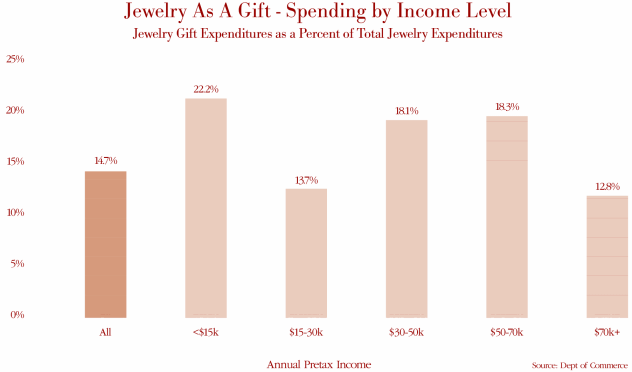 |

